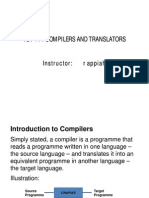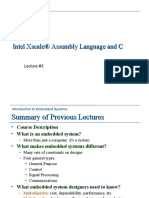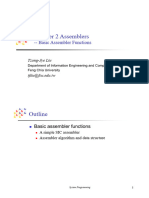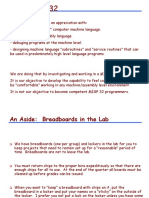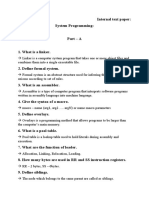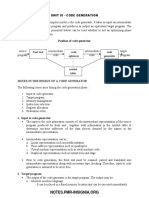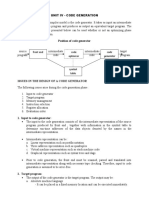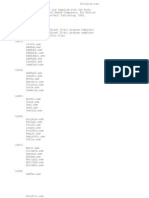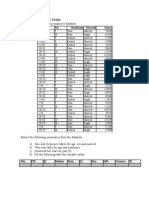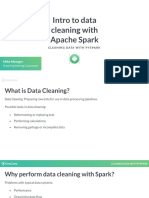0 ratings0% found this document useful (0 votes)
37 views08 Tutorial 4
08 Tutorial 4
Uploaded by
SachinthaThis document provides an overview of compiling and running a computer program from source code. It discusses:
1. Translating source code to machine instructions with an assembler or compiler to create an object module.
2. Linking object modules together to resolve references and create an executable.
3. Loading the executable into memory, setting up arguments and registers, and starting the program's main function.
It also introduces dynamic linking, where library code is loaded only when needed rather than at program start.
Copyright:
© All Rights Reserved
Available Formats
Download as PDF, TXT or read online from Scribd
08 Tutorial 4
08 Tutorial 4
Uploaded by
Sachintha0 ratings0% found this document useful (0 votes)
37 views17 pagesThis document provides an overview of compiling and running a computer program from source code. It discusses:
1. Translating source code to machine instructions with an assembler or compiler to create an object module.
2. Linking object modules together to resolve references and create an executable.
3. Loading the executable into memory, setting up arguments and registers, and starting the program's main function.
It also introduces dynamic linking, where library code is loaded only when needed rather than at program start.
Original Description:
computer architecture tutorial 4
Copyright
© © All Rights Reserved
Available Formats
PDF, TXT or read online from Scribd
Share this document
Did you find this document useful?
Is this content inappropriate?
This document provides an overview of compiling and running a computer program from source code. It discusses:
1. Translating source code to machine instructions with an assembler or compiler to create an object module.
2. Linking object modules together to resolve references and create an executable.
3. Loading the executable into memory, setting up arguments and registers, and starting the program's main function.
It also introduces dynamic linking, where library code is loaded only when needed rather than at program start.
Copyright:
© All Rights Reserved
Available Formats
Download as PDF, TXT or read online from Scribd
Download as pdf or txt
0 ratings0% found this document useful (0 votes)
37 views17 pages08 Tutorial 4
08 Tutorial 4
Uploaded by
SachinthaThis document provides an overview of compiling and running a computer program from source code. It discusses:
1. Translating source code to machine instructions with an assembler or compiler to create an object module.
2. Linking object modules together to resolve references and create an executable.
3. Loading the executable into memory, setting up arguments and registers, and starting the program's main function.
It also introduces dynamic linking, where library code is loaded only when needed rather than at program start.
Copyright:
© All Rights Reserved
Available Formats
Download as PDF, TXT or read online from Scribd
Download as pdf or txt
You are on page 1of 17
Chapter 2
Instructions: Language of the
Computer
Tutorial 4
Character Data
Byte / Halfword Operations
String Copy Example
Scanf and Printf Examples
Linking and Loading
Chapter 2 — Instructions: Language of the Computer — 2
§2.9 Communicating with People
Character Data
Byte-encoded character sets
ASCII: 128 characters
95 graphic, 33 control
Latin-1: 256 characters
ASCII, +96 more graphic characters
Chapter 2 — Instructions: Language of the Computer — 3
§2.9 Communicating with People
Character Data
Unicode: 32-bit character set
Used in Java, C++ wide characters, …
Most of the world’s alphabets, plus symbols
UTF-8, UTF-16: variable-length encodings
Chapter 2 — Instructions: Language of the Computer — 4
Byte/Halfword Operations
ARM byte load/store
Word is 4bytes.
When loading chars no need to load whole word(char is 1 byte)
String processing is a common case
LDRB r0, [sp,#0] ; Read byte from source
STRB r0, [r10,#0] ; Write byte to destination
Sign extend to 32 bits
LDRSB ; Sign extends to fill leftmost 24 bits
LDRB ; leftmost 24 bits filled by 0
Chapter 2 — Instructions: Language of the Computer — 5
Byte/Halfword Operations
ARM halfword load/store
LDRH r0, [sp,#0] ; Read halfword (16 bits) from source
STRH r0,[r12,#0] ; Write halfword (16 bits) to destination
Sign extend to 32 bits
LDRSH ; Sign extends to fill leftmost 16 bits
Chapter 2 — Instructions: Language of the Computer — 6
String Copy Example
C code (naïve):
Null-terminated string
void strcpy (char x[], char y[]){
int i;
i = 0;
while ((x[i]=y[i])!='\0')
i++;
}
Addresses of x, y in registers r0, r1
i in register r4
Chapter 2 — Instructions: Language of the Computer — 7
String Copy Example
ARM code:
If r4 - r11 registers are used inside a function , they should be preserved
strcpy:
SUB sp,sp, #4 ; adjust stack for 1 item
STR r4,[sp,#0] ; save r4 r1 contains base address of y
MOV r4,#0 ; i = 0 r0 contains base address of x
L1: ADD r2,r4,r1 ; addr of y[i] in r2
LDRB r3, [r2, #0] ; r3 = y[i]
ADD r12,r4,r0 ; ; Addr of x[i] in r12
STRB r3 [r12, #0] ; x[i] = y[i]
CMP r3,#0 Null terminated string stored in the memory as the 0
BEQ L2 ; exit loop if y[i] == 0
ADD r4,r4,#1 ; i = i + 1
B L1 ; next iteration of loop
L2: LDR r4, [sp,#0] ; restore saved r4
ADD sp,sp, #4 ; pop 1 item from stack
MOV pc,lr ; return
Chapter 2 — Instructions: Language of the Computer — 8
scanf and printf (example01.s)
Read a number from stdin and print to the stdout
sub sp, sp, #4 @allocate stack for input
ldr r0, =formats @scanf to get an integer
mov r1, sp r0 , r1 are the arguments of scanf , printf
bl scanf load input val to a reg @scanf("%d",sp) Scanned value store in stac
ldr r1, [sp,#0] @copy from stack to register
add sp, sp, #4 @release stack
ldr r0, =formatp @format for printf
bl printf @printf
.asciz is used to specify that ascii values are being used
formats , formatp are just labels .data @ data memory
formats: .asciz "%d“
formatp: .asciz "The number is %d\n“
.data section is used to store static data.
.text section is used to store the instructions.
.asciz are for string literals. Assembler inserts \0 after the string
Chapter 2 — Instructions: Language of the Computer — 9
Some Examples to try
Read two integers x and y, then Print x+y
Example02.s
Read two integers x and y, thenPrint x * 2 y
Example03.s
Write an ARM Assembly program to read
two numbers and print whether they are
equal or not
Example04.s
Chapter 2 — Instructions: Language of the Computer — 10
Some Examples
Write an ARM Assembly program to read a
number (N) and print numbers from 1 to N
Example05.s
Write a function to find string length and
call it from main
Example06.s
Chapter 2 — Instructions: Language of the Computer — 11
§2.12 Translating and Starting a Program
Translation and Startup
Many compilers produce
object modules directly
When using library functions
binary Compiled
Static linking
Stored in the hardware
Chapter 2 — Instructions: Language of the Computer — 12
Producing an Object Module
Assembler (or compiler) translates program into
machine instructions
Provides information for building a complete
program from the pieces
Header: described contents of object module
Text segment: translated instructions
Static data segment: data allocated for the life of the
program
Relocation info: for contents that depend on absolute
location of loaded program
Symbol table: global definitions and external refs
Debug info: for associating with source code
Chapter 2 — Instructions: Language of the Computer — 13
Linking Object Modules
Produces an executable image
1. Merges segments
2. Resolve labels (determine their addresses)
3. Patch location-dependent and external refs
Could leave location dependencies for
fixing by a relocating loader
But with virtual memory, no need to do this
Program can be loaded into absolute location
in virtual memory space
Chapter 2 — Instructions: Language of the Computer — 14
Loading a Program
Load from image file on disk into memory
1. Read header to determine segment sizes
2. Create virtual address space
3. Copy text and initialized data into memory
Or set page table entries so they can be faulted in
4. Set up arguments on stack
5. Initialize registers
6. Jump to startup routine
Copies arguments to r0, … and calls main
When main returns, startup terminates with exit
system call
Chapter 2 — Instructions: Language of the Computer — 15
Dynamic Linking
Only link/load library procedure when it is
called
Requires procedure code to be relocatable
Avoids image bloat caused by static linking of
all (transitively) referenced libraries
Automatically picks up new library versions
Chapter 2 — Instructions: Language of the Computer — 16
Lazy Linkage
Indirection table
Stub: Loads routine ID,
Jump to linker/loader
Linker/loader code
Dynamically
mapped code
Chapter 2 — Instructions: Language of the Computer — 17
You might also like
- SLIDES - ICT444!1!17 (Compatibility Mode)Document17 pagesSLIDES - ICT444!1!17 (Compatibility Mode)kwekutmenNo ratings yet
- LECTURE 4 - ECE521 - MP Assembly LanguageDocument43 pagesLECTURE 4 - ECE521 - MP Assembly LanguageAmar MursyidNo ratings yet
- Municating With People & Parallelism and Instruction SynchronizationDocument12 pagesMunicating With People & Parallelism and Instruction SynchronizationSashank PNo ratings yet
- Assembly NotesDocument18 pagesAssembly NotesMoazzam SonuNo ratings yet
- CPU Cycle and Assembly ProgrammingDocument8 pagesCPU Cycle and Assembly ProgrammingRandom ThingsNo ratings yet
- PowerPC Assembly OverviewDocument9 pagesPowerPC Assembly Overviewbisti tuNo ratings yet
- System Architecture: Lab Notes For Week 1: The MIPS CPU, Assembly Programming 1 Introduction To System ArchitectureDocument7 pagesSystem Architecture: Lab Notes For Week 1: The MIPS CPU, Assembly Programming 1 Introduction To System ArchitectureNabil AlzeqriNo ratings yet
- Objective: For This Lab You Will Run Your Assembly Programs With PcspimDocument8 pagesObjective: For This Lab You Will Run Your Assembly Programs With PcspimsmalldragonvtNo ratings yet
- CTCD Unit 4Document25 pagesCTCD Unit 4Ranjit47 HNo ratings yet
- Unit 2Document28 pagesUnit 2xboyxman1000No ratings yet
- Assembly Lab 6 Fall2018Document7 pagesAssembly Lab 6 Fall2018Usama Javid MughalNo ratings yet
- Week4 InstructionsDocument36 pagesWeek4 InstructionsAfs AsgNo ratings yet
- Module 2 - Assemblers & Macro ProcessorDocument8 pagesModule 2 - Assemblers & Macro ProcessorSky JNo ratings yet
- Code Generation 5th Year Computer Science CourseDocument20 pagesCode Generation 5th Year Computer Science CourseMekonnen SolomonNo ratings yet
- Lecture 1 Notes: Introduction: 1.1 Why Use A Language Like C++?Document9 pagesLecture 1 Notes: Introduction: 1.1 Why Use A Language Like C++?GBonga MossesNo ratings yet
- Design of A General Purpose 8 Bit RISC Processor For Computer Architecture LearningDocument30 pagesDesign of A General Purpose 8 Bit RISC Processor For Computer Architecture LearningGuillermo Esqueda SilvaNo ratings yet
- Introduction To x64 AssemblyDocument4 pagesIntroduction To x64 AssemblySoreanu Dumitru-Paul100% (1)
- 04 - Programming LayerDocument59 pages04 - Programming LayerLuân NguyễnNo ratings yet
- LAB5 Implementation of String InstructionsDocument4 pagesLAB5 Implementation of String Instructionsalihassan009669No ratings yet
- Virtualization II-2019-SysVMDocument47 pagesVirtualization II-2019-SysVM楊鎮維No ratings yet
- ARM Assembly Programming Using Raspberry Pi GUI PDFDocument23 pagesARM Assembly Programming Using Raspberry Pi GUI PDFKaren GarzaNo ratings yet
- Pep 8 PaperDocument5 pagesPep 8 PaperBrent ButlerNo ratings yet
- MPL Writeup 2Document11 pagesMPL Writeup 2anirudha4yearNo ratings yet
- MPL LabmanualDocument76 pagesMPL LabmanualHide And hideNo ratings yet
- Lab Manual of MPDocument35 pagesLab Manual of MPShaam mkNo ratings yet
- Lab Session 1Document13 pagesLab Session 1Kulsoom Nasir HussainNo ratings yet
- ApplicationsDocument44 pagesApplicationsmerinjose123100% (1)
- Mic Micro ProjectDocument12 pagesMic Micro ProjectGAMING PLUS TECHNo ratings yet
- MP Lab ManualDocument103 pagesMP Lab Manualashish chavanNo ratings yet
- Introduction To Assembly LanguageDocument65 pagesIntroduction To Assembly LanguageDaryl Ivan Hisola100% (4)
- Code Generation: Issues in The Design of A Code GeneratorDocument33 pagesCode Generation: Issues in The Design of A Code Generatorவெ. விஷ்வாNo ratings yet
- Chapter 03 Assembly LanguageDocument96 pagesChapter 03 Assembly LanguageA Sai BhargavNo ratings yet
- System ProgrammingDocument48 pagesSystem ProgrammingUsman Ghani100% (2)
- Tema 2 GII EC Lenguaje Ensamblador Latest PDFDocument88 pagesTema 2 GII EC Lenguaje Ensamblador Latest PDFJorge ArmasNo ratings yet
- 4085 Cao Ass6Document4 pages4085 Cao Ass614SYCMIIIShruti DawangeNo ratings yet
- ARM Slides Part2Document17 pagesARM Slides Part2Asmitha G ee22b030No ratings yet
- Embedded Systems: Department of Electrical and Computer Engineering MWU UniversityDocument32 pagesEmbedded Systems: Department of Electrical and Computer Engineering MWU UniversitySamuel AdamuNo ratings yet
- MIPS Assembly Language Programming: Computer Organization and AssemblyDocument33 pagesMIPS Assembly Language Programming: Computer Organization and AssemblySardar IrfanullahNo ratings yet
- 03 Assembly Language ProgrammingDocument33 pages03 Assembly Language ProgrammingManoj VelumaniNo ratings yet
- Elements of Assembly Language: How To Develop Assembly Language Programs Directives in MASMDocument48 pagesElements of Assembly Language: How To Develop Assembly Language Programs Directives in MASMmanjuojha90No ratings yet
- Compiler Design Code GenerationDocument4 pagesCompiler Design Code GenerationNera AjahhNo ratings yet
- LAB Memory AccessDocument8 pagesLAB Memory AccessAnimesh JainNo ratings yet
- Unit 1 Introduction To C LanguageDocument58 pagesUnit 1 Introduction To C LanguageneedmoneyforomniNo ratings yet
- CC 7Document20 pagesCC 7its.vikas013No ratings yet
- MP - Lab Manual SRCOEDocument59 pagesMP - Lab Manual SRCOEkartikipahilwan218No ratings yet
- SP2.1 Assembler-Basic Assembler FunctionsDocument13 pagesSP2.1 Assembler-Basic Assembler Functionstanjuner01No ratings yet
- MIPS Quick TutorialDocument5 pagesMIPS Quick TutorialSimran SuriNo ratings yet
- System ProgrammingDocument26 pagesSystem ProgrammingMohan Rao MamdikarNo ratings yet
- Objective: To Understand The Basic Concept and Functionality of Assembly LanguageDocument9 pagesObjective: To Understand The Basic Concept and Functionality of Assembly LanguageKAMRAN KHANNo ratings yet
- MIPS 32 in BriefDocument29 pagesMIPS 32 in BriefPooja VashisthNo ratings yet
- Patt Patel CH 07Document22 pagesPatt Patel CH 07Nirmal GuptaNo ratings yet
- System Software Solve PaperDocument13 pagesSystem Software Solve PaperArthiNo ratings yet
- Lab 2Document12 pagesLab 2DavidNo ratings yet
- Code Generation PDFDocument19 pagesCode Generation PDFRagav SrvNo ratings yet
- Full Download x64 Assembly Language Step-by-Step: Programming With Linux (Tech Today), 4th Edition Jeff Duntemann PDFDocument64 pagesFull Download x64 Assembly Language Step-by-Step: Programming With Linux (Tech Today), 4th Edition Jeff Duntemann PDFnkonkihaivazNo ratings yet
- Week008-Microprocessor Systems Assessement 2Document15 pagesWeek008-Microprocessor Systems Assessement 2Datu Prince100% (1)
- CS602PC - Compiler - Design - Lecture Notes - Unit - 4Document19 pagesCS602PC - Compiler - Design - Lecture Notes - Unit - 4Senthil Kumar SkumarNo ratings yet
- Big Data Computing Spark Basics and RDD: Ke YiDocument43 pagesBig Data Computing Spark Basics and RDD: Ke YiPatrick LiNo ratings yet
- Assembly Programming:Simple, Short, And Straightforward Way Of Learning Assembly LanguageFrom EverandAssembly Programming:Simple, Short, And Straightforward Way Of Learning Assembly LanguageRating: 5 out of 5 stars5/5 (2)
- Introduction to Computer Organization: An Under the Hood Look at Hardware and x86-64 AssemblyFrom EverandIntroduction to Computer Organization: An Under the Hood Look at Hardware and x86-64 AssemblyNo ratings yet
- Individual Programming 2 (Part 2)Document5 pagesIndividual Programming 2 (Part 2)SachinthaNo ratings yet
- Assignment 1: COMP202, Winter 2021 Due: Friday, Feb. 12, 11:59pmDocument12 pagesAssignment 1: COMP202, Winter 2021 Due: Friday, Feb. 12, 11:59pmSachinthaNo ratings yet
- CSEB334 Group Project Sem2 - 2021Document3 pagesCSEB334 Group Project Sem2 - 2021SachinthaNo ratings yet
- CSBP 221 - Programming Lab I Fall 2021: Exercise 1Document3 pagesCSBP 221 - Programming Lab I Fall 2021: Exercise 1SachinthaNo ratings yet
- 09 Verilog InstallationDocument6 pages09 Verilog InstallationSachinthaNo ratings yet
- 01 Diode-1Document23 pages01 Diode-1SachinthaNo ratings yet
- 09 Verilog Tutorial 1Document12 pages09 Verilog Tutorial 1SachinthaNo ratings yet
- CO224 - 2020 July Omputer Rchitecture: Suru AwinneDocument11 pagesCO224 - 2020 July Omputer Rchitecture: Suru AwinneSachinthaNo ratings yet
- 24-Port Gigabit Desktop/Rackmountable Switch: DGS-1024DDocument2 pages24-Port Gigabit Desktop/Rackmountable Switch: DGS-1024DLâm NguyễnNo ratings yet
- Nmap For Pentester Host Discovery 1705164972Document19 pagesNmap For Pentester Host Discovery 1705164972teknik informatikaNo ratings yet
- 2v0-602 EXAM TESTDocument10 pages2v0-602 EXAM TESTJESUS SANCHEZNo ratings yet
- Subject Code: 275Document3 pagesSubject Code: 275RifaNo ratings yet
- File ListDocument6 pagesFile ListboyrstuvwxyzNo ratings yet
- Emenuhan Kebutuhan Nutrisi Balita Yang Dirawat Inap Di Rumah SakitDocument7 pagesEmenuhan Kebutuhan Nutrisi Balita Yang Dirawat Inap Di Rumah SakitAnnisa Nur Majidah100% (1)
- Anatomy of A Program in MemoryDocument19 pagesAnatomy of A Program in MemoryVictor J. PerniaNo ratings yet
- Notes On 8086: Flag RegisterDocument8 pagesNotes On 8086: Flag Registersunit kumar senNo ratings yet
- Manual IndexDocument2 pagesManual IndexGen FetishNo ratings yet
- Unit I - Lesson 4 - Basic Structure of HTMLDocument13 pagesUnit I - Lesson 4 - Basic Structure of HTMLmllalaguna100% (1)
- Log 1dea6e0d78d1Document61 pagesLog 1dea6e0d78d1davidNo ratings yet
- DNS Server Installation in CentOS 6Document8 pagesDNS Server Installation in CentOS 6Adil BoukhiraNo ratings yet
- Smarty Cheat SheetDocument1 pageSmarty Cheat SheetGoCatGoNo ratings yet
- Ts 7250 Manual Rev2.3Document44 pagesTs 7250 Manual Rev2.3bobsmithconkersNo ratings yet
- Ism ProjectDocument37 pagesIsm ProjectJohn JosephNo ratings yet
- GIGABYTE - b2303 - 8I848P2.01Document38 pagesGIGABYTE - b2303 - 8I848P2.01Leo MeleanNo ratings yet
- Oracle DBA InterviewDocument73 pagesOracle DBA InterviewjaydevdangarNo ratings yet
- Programming Element PDFDocument37 pagesProgramming Element PDFSky FireNo ratings yet
- Filesystem - How To Configure Systemd To Ignore Fstab Drive Mount Failures? - Ask UbuntuDocument2 pagesFilesystem - How To Configure Systemd To Ignore Fstab Drive Mount Failures? - Ask UbuntuASNo ratings yet
- Question 1 of Mid TermDocument1 pageQuestion 1 of Mid TermresearchsupportNo ratings yet
- DSA Cheat SheetDocument24 pagesDSA Cheat SheetDebasish SenapatyNo ratings yet
- 6-Operating SystemDocument3 pages6-Operating Systemjackhacktivist17No ratings yet
- A-Level: Computer ScienceDocument25 pagesA-Level: Computer ScienceHarALevelComputing JNo ratings yet
- CS-2500 ASTM Host Interface Specifications For Out of US: Sysmex CorporationDocument58 pagesCS-2500 ASTM Host Interface Specifications For Out of US: Sysmex CorporationadreyFedorcovNo ratings yet
- Unit 1 JDBCDocument16 pagesUnit 1 JDBCroshnibijuNo ratings yet
- Linear Block CodingDocument18 pagesLinear Block CodingPavuluri SairamNo ratings yet
- CCN Lab Project ReportDocument34 pagesCCN Lab Project ReportMuhammad AlianNo ratings yet
- CIT8 Moon 44Document391 pagesCIT8 Moon 44ArnoldMamunNo ratings yet
- Cleaning Data With PySpark Chapter1Document20 pagesCleaning Data With PySpark Chapter1Fgpeqw0% (1)
- SLVM SingleNode Online Volume Re-Configuration/ JDocument11 pagesSLVM SingleNode Online Volume Re-Configuration/ JrobinNo ratings yet
